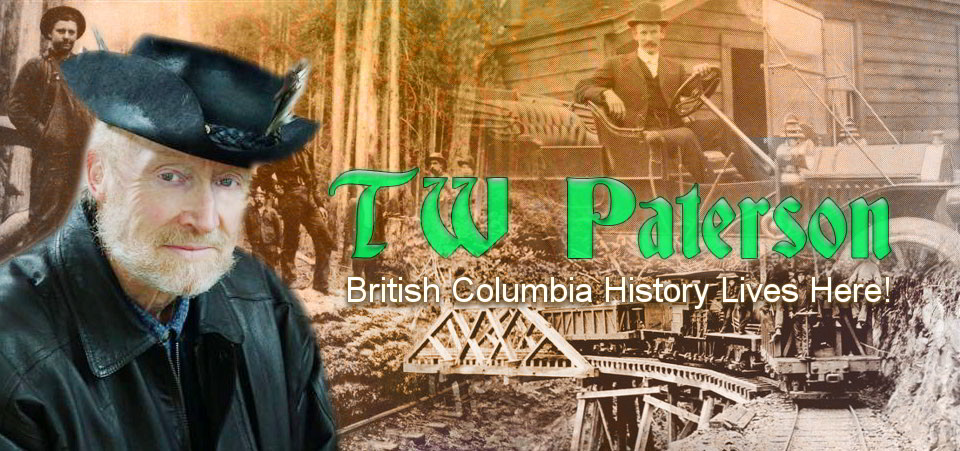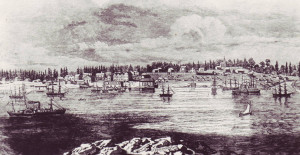Victoria, B.C. Waterfront to Undergo Transformation
“Victoria’s Inner Harbour has come a long way since the days when it was surrounded by industrial operations that turned the water into an open sewer…” noted the Times–Colonist in a recent editorial.
No doubt the editor’s reference to the harbour’s past commercial enterprises didn’t include its first major industry, the selling of ‘tanglefoot’–rotgut–whiskey and degenerative disease by the boatload. This was when Victoria was still a palisaded outpost of the Hudson’s Bay Co., in the days of, and following, the Fraser River gold rush.
‘Respectable’ Victoria merchants grew rich from illegal liquor sales
to an estimated 20,000 white newcomers who joined several thousand local Songhees and other First Nations peoples from northern Vancouver and the Queen Charlotte (Haida Gwaii) islands. This unholy mix of nations, races, creeds and cultures created an overwhelming demand for liquor and some of Victoria’s leading (and ‘respectable’) merchants were quick to fill the demand.
Pioneer journalist D.W. Higgins, one of the most informed British Columbians of his time, has left us a graphic description of the devil’s brew that was shipped, in dead of night, from Ship’s Point, now a parking lot and one of the sites being considered by Victoria City Council for make-over:
“The so-called whiskey was the vilest stuff that the ingenuity of wicked-minded and avaricious white men ever concocted. What it was composed of was known only to the concoctors. I was told that it was made of alcohol diluted with water toned up with an extract of red pepper and coloured so as to resemble the real thing. It was conveyed to the [Songhees reserve immediately across the Inner Harbour] under cover of night by the boatload.
“What the Indian wanted was something hot
–something that would burn holes through his unaccustomed stomach and never stop burning holes until it reached his heels. Quality was not considered. The rotgut must be cheap as well as pungent, and these two elements being present, the sale was rapid and profitable.”
Within months the vast encampments on the harbour’s western shore were a brawling hive of degradation as tens of thousands of gallons of booze were dispatched from the wholesale liquor import warehouses at the foot of Johnson Street for $1 a bottle. Each sale of the diluted rotgut meant a 90 per cent profit for the peddler and contributed directly to the social breakdown of its consumers.
“Did the police know that this infamous business was being carried on under their noses and eyes?” Higgins asked his readers in a series of reminiscences in the Colonist in 1904. “They were well aware of the methods by which the Indians were being cleared off from the face of the earth.”
Corrupt city police turned a blind eye
All city police officers of the day had been “taken care of,” he wrote. While other crimes were diligently investigated, the respected owners of the Johnson Street warehouses had continued business as usual, with sloops, rowboats and dugout canoes ferrying thousands of liquid cargoes across the darkened harbour waters. The bootleggers, said Higgins, “were immune, and justice was not alone blind–she was so deaf that she could not hear the plaintive cries of the wretched victims of man’s greed and rapacity as they rent the night air and seemed to call down heaven’s vengeance upon their poisoners.”
The steady slaughter of an unsuspecting indigenous populace marched unchecked. Where reason and an advanced culture had ruled, “debauchery, outrage and death” prevailed. Not only across Victoria Harbour but along much of the west coast as tanglefoot whiskey was sold by mobile bootleggers from Washington Territory to Alaska.
What whiskey began, disease ended as British warships, the colonial policemen of the day, could do little against the illegal liquor trade.
Concluded Higgins:
“I might continue to cite tragedy after tragedy which resulted directly from the sale of liquor to the poor red man by white men who worked under the actual protection of the [Victoria] constabulary. But the instances I have given will suffice to show the condition of things that prevailed in and about this Christian town, beneath the shadows of church spires and within earshot and stone’s throw of the peaceful and happy homes of pioneer settlers.”
If you find it difficult to believe D.W. Higgins, you can consult many irreproachable records in the British Coliumbia Provincial Archives. In his book The Impact of the White Man, anthropologist Wilson Duff cited disease, primarily smallpox, as the province’s natives’ greatest enemy. One epidemic which began in Victoria with the arrival of an ailing passenger from San Francisco raged throughout the province for over two years.
Smallpox killed a third of the Native population
Within that short period it’s estimated that one-third of the First Nations population, almost 20,000 souls, perished.
But the devastating effects of liquor, physically and psychologically, can’t be refuted. More than epidemic, more than the white man’s advanced ways, liquor destroyed the complex Native culture, his integrity and his independence. Abetted by the ignorant and poisoned by the profiteer, the wholesale destruction of B.C.’s first citizens is an ignoble chapter in provincial history–for which, even today, we should be ashamed.
Update, July 2014
The foot of Wharf Street, site of the original Hudson’s Bay Co. warehouse and launchpad for thousands of illicit cargoes in the old days, is in the news. The Times-Colonist has reported that what for long has been a parking lot is due for major redevelopment as a ‘people place’ and float plane terminal that will also include a First Nations Cultural Centre.
I don’t know if that’s irony, conscience or opportunism but even this belated and token recognition of the Songhees people is welcome


Merci! TW
I have read both of D.W. Higgins books and though he may have embellished the truth somewhat I believe his books would be good reading for anyone interested in the history of Victoria as well as BC. I was pleased and saddened at the same time as to how we….the new people to this land…..imposed ourselves as friends to the original landlords of this beautiful province before ripping it away from them in the most diobolical way.
I love D.W. Higgins, ’embellisher’ or no. He offers an insight to people and events that is unsurpassed.
As for ‘our'(white) takeover, we have much to answer for above and beyond the residential schools tragedy. I hope to address some of these issues in future posts. –TWP